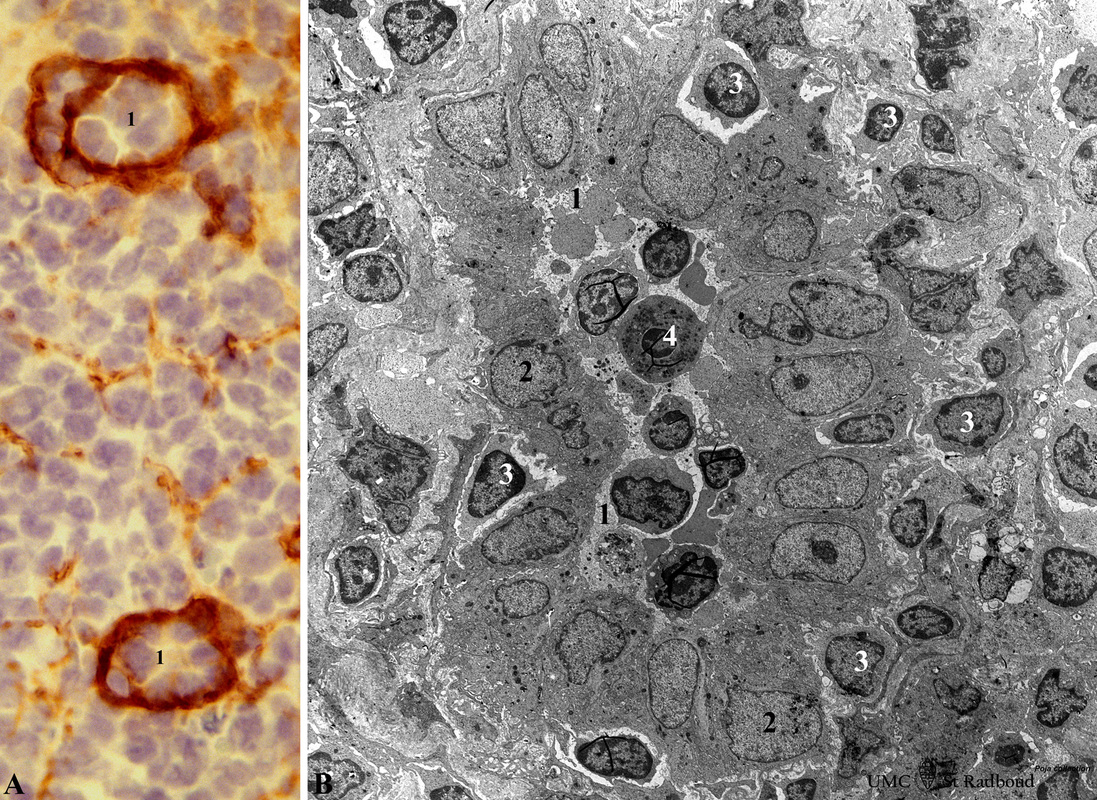2.3 POJA-L1028+1078
Title: High endothelial venules (HEV) (rat lymph node, human palatine tonsil)
Description: Stain: (A) Anti-laminin antibody and immunoperoxidase staining using diaminobenzidin (DAB)/ haematoxylin counterstained on frozen section of lymph node; (B) electron microscopy (palatine tonsil).
(A): Using an antibody against laminin brown-stained basement membranes are outlined demonstrating postcapillary venules or high endothelial venules (HEV’s) (1) located in the paracortical areas of a lymph node. In between the blue-stained nuclei of different types of cells faintly brown-stained threads indicate patches of basement membrane-material (collagen IV) produced by reticular cells are visible.
(B): In tonsillar areas e.g. the palatine tonsil, the same type of HEV’s (1) are also encountered. Lining endothelial cells (2) are distinctly cuboidal and surrounded by connective tissue, free lymphocytes (3) as well as invading lymphocytes (3) with different electron-densities.
Within the lumen (1) several lymphocytes and a single neutrophilic granulocyte (4) are present.
Background: These specialized postcapillary venules or so-called high endothelial venules (HEV) are lined by cuboidal or columnar endothelial cells that possess specific receptors for (antigen-primed) lymphocytes. These are the sites of entry of these lymphocytes into the lymph node (lymphocyte homing mechanism) where they leave the blood stream through these HEV’s and subsequently by diapedesis between the endothelial cells B lymphocytes migrate to the lymphatic follicles in the cortex but T lymphocytes remain in the thymus-dependent area of the paracortex.
Keywords/Mesh: lymphatic tissue, postcapillary venule, high endothelial venules (HEV), histology, electron microscopy, POJA collection
Title: High endothelial venules (HEV) (rat lymph node, human palatine tonsil)
Description: Stain: (A) Anti-laminin antibody and immunoperoxidase staining using diaminobenzidin (DAB)/ haematoxylin counterstained on frozen section of lymph node; (B) electron microscopy (palatine tonsil).
(A): Using an antibody against laminin brown-stained basement membranes are outlined demonstrating postcapillary venules or high endothelial venules (HEV’s) (1) located in the paracortical areas of a lymph node. In between the blue-stained nuclei of different types of cells faintly brown-stained threads indicate patches of basement membrane-material (collagen IV) produced by reticular cells are visible.
(B): In tonsillar areas e.g. the palatine tonsil, the same type of HEV’s (1) are also encountered. Lining endothelial cells (2) are distinctly cuboidal and surrounded by connective tissue, free lymphocytes (3) as well as invading lymphocytes (3) with different electron-densities.
Within the lumen (1) several lymphocytes and a single neutrophilic granulocyte (4) are present.
Background: These specialized postcapillary venules or so-called high endothelial venules (HEV) are lined by cuboidal or columnar endothelial cells that possess specific receptors for (antigen-primed) lymphocytes. These are the sites of entry of these lymphocytes into the lymph node (lymphocyte homing mechanism) where they leave the blood stream through these HEV’s and subsequently by diapedesis between the endothelial cells B lymphocytes migrate to the lymphatic follicles in the cortex but T lymphocytes remain in the thymus-dependent area of the paracortex.
Keywords/Mesh: lymphatic tissue, postcapillary venule, high endothelial venules (HEV), histology, electron microscopy, POJA collection

